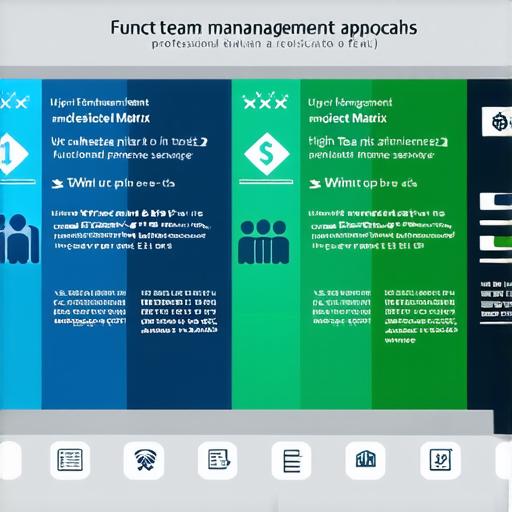Functional Matrix Approach
The functional matrix approach is a top-down approach that involves assigning project managers to specific functions within an organization. This approach allows organizations to leverage the expertise of functional managers while still maintaining control over the project.
One of the main benefits of the functional matrix approach is that it allows organizations to tap into the expertise of functional managers who have experience in managing projects related to their specific function. For example, a marketing manager with experience in managing marketing campaigns may be assigned to manage a project that involves developing a new product launch campaign.
Another benefit of the functional matrix approach is that it allows for greater flexibility in project management. Functional managers can be assigned to different projects as needed, allowing organizations to quickly adapt to changing project requirements.
However, the functional matrix approach also has some drawbacks. One major drawback is that it can lead to conflicts between functional managers who may have competing priorities or interests. This can result in delays and other issues in project management.
Another drawback of the functional matrix approach is that it can be difficult to maintain clear lines of authority and responsibility. Functional managers may have different levels of experience or expertise, making it challenging to determine who should be responsible for specific aspects of the project.

Dedicated Team Approach
The dedicated team approach involves assigning a small group of highly skilled professionals to manage a specific project. This approach allows organizations to focus on the needs of the project and avoid distractions from other responsibilities.
One of the main benefits of the dedicated team approach is that it allows for greater focus on the project at hand. Dedicated team members can work together seamlessly, allowing for faster and more efficient project management.
Another benefit of the dedicated team approach is that it allows for better communication and collaboration between team members. Since everyone involved in the project has a shared goal, they are more likely to work together effectively and share knowledge and insights.
However, the dedicated team approach also has some drawbacks. One major drawback is that it can be expensive to assemble a highly skilled team. Organizations may need to hire new team members or pay for specialized training to ensure that they have the necessary skills and expertise.
Another drawback of the dedicated team approach is that it can be difficult to manage projects with large budgets or complex requirements. Dedicated teams may not have the resources or expertise to handle every aspect of the project, making it challenging to ensure that all needs are met.
Case Studies and Personal Experiences
Let’s take a look at some real-life examples to illustrate how these approaches work in practice.
Functional Matrix Approach
:
A marketing team within a large corporation was tasked with developing a new product launch campaign. The team consisted of functional managers from various departments, including marketing, sales, and customer service. Each manager brought their own unique expertise and experience to the project, allowing the team to develop a highly effective campaign that exceeded expectations.
Dedicated Team Approach
:
A software development firm was tasked with building a new enterprise resource planning (ERP) system for a large manufacturing company. The dedicated team consisted of software engineers, project managers, and quality assurance specialists who worked together to develop the system from scratch. Despite the challenges of managing such a complex project, the team delivered the system on time and within budget, earning praise from the client.
Strengths and Weaknesses Comparison
Functional Matrix Approach
:
- Leverages the expertise of functional managers to manage projects related to their specific function.
- Allows for greater flexibility in project management.
Weaknesses:
- Can lead to conflicts between functional managers who may have competing priorities or interests.
- Can be difficult to maintain clear lines of authority and responsibility.
Dedicated Team Approach
:
- Allows for greater focus on the project at hand.
- Encourages better communication and collaboration between team members.
Weaknesses:
- Can be expensive to assemble a highly skilled team.
- May not have the resources or expertise to handle every aspect of the project.
Which Approach is Right for You?
The choice between the functional matrix and dedicated team approach will depend on several factors, including the nature of the project, the available resources, and the organization’s goals and priorities.
If you have a small project with clear requirements and a limited budget, the dedicated team approach may be the best option. The dedicated team can work together seamlessly to deliver the project on time and within budget, without the distractions of other responsibilities.
On the other hand, if you have a larger project with complex requirements and multiple stakeholders, the functional matrix approach may be more appropriate. This approach allows you to leverage the expertise of functional managers while still maintaining control over the project, ensuring that all needs are met.
FAQs
Q: What is the difference between the functional matrix and dedicated team approaches in project management?
A: The functional matrix approach involves assigning project managers to specific functions within an organization, while the dedicated team approach involves assigning a small group of highly skilled professionals to manage a specific project.
Q: Which approach is better for small projects with clear requirements?
A: The dedicated team approach may be better for small projects with clear requirements, as it allows for greater focus on the project at hand and encourages better communication and collaboration between team members.
Q: Which approach is better for larger projects with complex requirements?
A: The functional matrix approach may be better for larger projects with complex requirements, as it allows you to leverage the expertise of functional managers while still maintaining control over the project.
